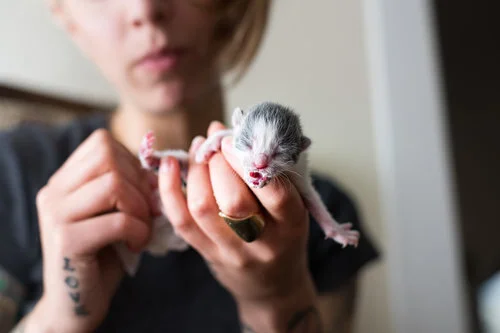Upper Respiratory infections
If you've rescued a kitten that has discharge from the nose and/or eyes, and you're hearing frequent sneezing or other respiratory noises, chances are they've got a URI. Upper respiratory infections (URIs) are present in a high proportion of kittens rescued from shelters and outdoors due to their decreased immunity and the high risk of exposure to bacterial and viral agents. While the common cold might not seem like a big deal to a human, these symptoms can be very dangerous for a tiny kitten, and should be addressed urgently.
URIs should be addressed right away. If you see yellow-green mucus, talk to a veterinarian about getting the kitten on an antibiotic right away.
In addition to treating with an antibiotic, you can support the kitten's recovery by providing nursing care at home.
Keep the eyes and nose clear of discharge by gently patting with a warm compress to soften and wipe away any crust. If the eyes are crusty with yellow-green mucus, talk to a vet about providing an ophthalmic antibiotic, which can quickly help the eyes heal.
Use a nebulizer to help open the airway. A veterinarian can prescribe a nebulizer solution that will help the kitten. You can also place the kitten outside of a hot steamy shower for 10-15 minutes, which may help open the airway, but this will not be as impactful as a nebulizer.
Keep an eye on the kitten's appetite and make sure she is getting enough calorie intake. Kittens with severe URIs may be unable to latch or nurse, and may require syringe feeding or even tube feeding if the kitten is not able to eat.
Be sure that the kitten is staying hydrated. Kittens with severe URIs may not be able to nurse or eat, and can become dehydrated. Provide extra fluids, and give extra fluids if the kitten is dehydrated.
Your job is to help the kitten's essential functions keep working while the antibiotics fight the infection, so make sure you're giving them extra close care while recovering. With early intervention, antibiotic therapy and gentle nursing care at home, most kittens can kick a URI after 7-10 days.
Learn more about URIs from Kitten Lady's veterinarian, Dr. Erica Ellis, below.
What is the culprit?
Bacterial organisms like Bordetella bronchiseptica and Mycoplasma species as well as virii like feline rhinotracheitis virus and calicivirus can cause upper respiratory tract infections as well as infections of the eyes.
How is it transmitted?
These organisms are generally air borne and can remain in the environment for varying lengths of time.
What symptoms will the kitten show?
Common symptoms include mucoid discharge from the eyes and nose, sneezing, increased noise on breathing, and decreased appetite. Patients with calicivirus are more likely than others to also have oral ulcers, which may makenursing painful. They also may experience inflamed joints and difficulties walking.
How can I prevent it?
Quarantine new kittens in an isolated area with good airflow. Ascertain that kittens are vaccinated for FVRCP starting at 6 weeks; some high volume cat shelters are vaccinating even younger at 4 weeks. Every adult cat or permanent feline resident in your home should be up to date on their FVRCP vaccine, even if they live indoors only. Clean the kittens’ environments thoroughly and frequently. Make sure that quarantined kittens are not sharing toys, blankets, litter boxes or bowls and feeding utensils with other kittens. Wash your hands thoroughly in between handling different kittens. For those kittens known to have an infectious respiratory disease, it is best to designate one specific person to their care and a separate person or people to care for those kittens who are not showing symptoms.
How might my veterinarian diagnose it?
URIs are often diagnosed and treated based on clinical signs. It is rare that a veterinarian will attempt to determine which of the organisms discussed above has actually caused the symptoms because figuring this out can be invasive and expensive and has little affect on what medical therapy the kitten will be given.
How might my veterinarian treat it?
Medical therapy for URIs may include liquid oral antibiotics such as Clavamox, probiotics, lysine powder and/or a topical antibiotic for the eyes. You can also provide nebulization to these kittens by allowing them in the bathroom while you run a hot bath or shower. When their nasal passages are clogged they may have trouble smelling their food and may need to be enticed by mixing the food with water and briefly warming the food.
Helpful Hints for Vets
Remember that water soluble drugs are distributed into a larger volume in neonates, who have a lower fat content, and as such plasma concentrations of antibiotics may be lower. The author suggests increasing the dose of Clavamox to 25 mg/kg PO BID and concurrently administering probiotics.




